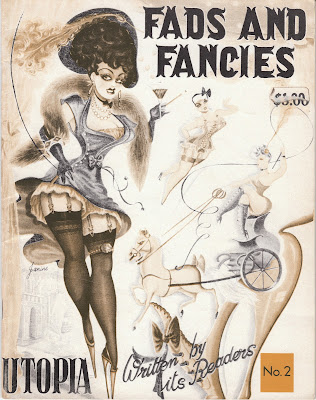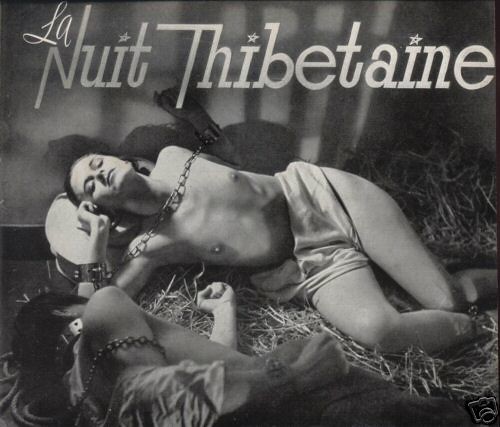Researching the previous post led me to the Klaw Archives, focused on the Irving Klaw’s 1940s-1950s bondage photosets and short films.

Researching the previous post led me to the Klaw Archives, focused on the Irving Klaw’s 1940s-1950s bondage photosets and short films.

The Vintage Sleaze blog has the story behind the Fads and Fancies fetish magazine, published in the late 1940s and early 1950s, and its signature artist known as Janine, actually a woman by the name of Reina Bull.

The astounding drawings by an anonymous artist known only as “Janine” who drew work for the sleazy Utopia magazine “Fads and Fancies” a British fetish magazine in the late 1940s and early 1950s. The work is no longer anonymous. It was done by a woman all right, but Janine wasn’t her real name. Fads and Fancies was published by Utopia, who printed fetish material remarkably similar to Nutrix and Irving Klaw, and at roughly the same time.
[…]
Janine had an incredible, unique, eccentric and curious style likely developed to cater to the audience. Particular parts of the plump participants protrude depending on the proclivities she wished to portray. Which is an alliterated way of saying big boobs and big butts. Kinky and unreal, but then certainly enticing to the readers who must have been “big” fans (pun intended.) To the rest of us, they look hilarious…Dolly Parton on Steroids! The work takes an “all-purpose” approach to fetishists. The artist can not figure out if she is titillating a shoe fetish, a butt fetish, a fat fetish, a breast fetish, a stocking fetish…if the idea of a fetish is to focus on one particular object, there was something kinky for all in Janine’s curious drawings. At the time, the fetish underground was not yet defined, but the publishers knew if they appealed to a handful of eccentricities, they would reach a market.
Fads belongs in a tradition of English fetish magazines that includes Photo Bits and London Life, and goes back at least to the 1870s when the Englishwoman’s Domestic Magazine took a turn for the pervy. The business model seems to be, “give the punters what they want”.
Nowadays, Rule 34 is in full effect and every fetish has its own Tumblr.

Vintage Sleaze has a fun tidbit of kink history. Sam Menning, an actor who also worked as a photographer, took fetish pics, including the great Betty Page.
Menning eventually became the “house” photographer of sorts for Gargoyle, a distributor of 4 x 5 nude photos with a fetish bent. Mind you, they were 1950’s photos of a fetish bent…which meant play-acting with rather dim and confused models being asked to look tough…dramatic to this day, but little more than lingerie ads with the models in black. Not MY cup of tea, but someone’s.
Meanwhile, Senator Estes Kefauver was gunning for porn publisher Samuel Roth, particularly for the fetish/kink pictures Kefauver thought were published by Roth.
It turns out that Kefauver and his puritan goons had confused Sam Menning, photographer for Gargoyle Sales Corp, with Samuel Roth, publisher of Gargoyle Books. This mistake wasn’t revealed until Kefauver had Roth on the stand testifying.
Just discovered the Vintage Scans blog. Unlike some vintage blogs, the author includes source information with his/her posts, which I appreciate as a historian.
Continuing my discussion of Orwell’s Nineteen Eighty-Four and the function of violence, here’s the Room 101 scene from the American 1956 film version.
Note that the story pretty closely follows the book and the other two film versions: the electric shocks, the “How many fingers?” routine, Winston seeing his degraded self in the mirror. You can see how much of a perverse initiator O’Brien is (called O’Connor in this adaptation), guiding Winston room to room, preparing him for each stage of his descent into hell.
From My Retrospace via Sociological Images, a discussion of the maledom-femsub spanking scene in the John Wayne-Maureen O’Hara Western film McLintock:

This image appeared prominently in publicity materials for the film, though in some cases Wayne is using what appears to be a small shovel or dustpan, while in others he is using his bare hand. Presumably this change is to “soften” the image, and perhaps strengthen the erotic connotations.
Also, in some images Wayne and O’Hara are alone, while in others there are plenty of observers, including even children. Often these scenes include a third party of one or more people observing the spanking, a common element of spanking literature and images, which adds elements of voyeurism and humiliation.
One particularly odd example image includes Superman using his x-ray vision to spy on, and control, his robot duplicate as it spanks Lois Lane.

My Retrospace says, “It seems to be all in good fun, right?” while Sociological Images says, “Lady spanking is a manifestation of the infantilization of women.” So how are we, from the perspective of 2010, supposed to view these images? Was this a coded/deflected reference to an uglier reality of spousal abuse in the mid-20th century? Or was this a plausibly deniable reference to sex? Or both?

Debra Hyde also has a Flickr set called “La Nuit Thibetaine”, a mid-20th century, presumably French set of photographs from a magazine that bear a striking resemblance to early scenes from The Story of O.
Why it is called “The Tibetan nights” is unclear. I imagine people who live in Tibet dress warmer at night.
Yoe, Craig. Secret Identity: The fetish art of Superman’s co-creator Joe Shuster HNA Books, 2008

Nights of Horror, a series of cheap pulp paperbacks published in early 1954 by an outfit known as “Malcla”, was the intersection point of three different stories.

The 20th century’s answer to Sade is probably Jean Genet, a novelist and playwright who developed a strange kind of ascent through descent, finding a kind of apotheosis. If heroism is impossible, one distinguishes oneself through cultivating betrayal and abuse.
One of his plays was The Balcony (1956), a surreal exploration of fantasy and fetish.
Most of the scenes occur in the Balcony, a “house of illusions” or a brothel, depending on the mood of Irma, the house’s madam. Irma presides over the constantly shifting boundaries of fantasy and reality, dealing with clients who want to be Bishops and Generals, and may in reality be those things, a pimp who is actually a cowardly crossdresser and a whore who wants to be a saint. The Judge insists on hearing “true confessions” from a whore dressed as a criminal, who technically is a criminal, but the Judge shrinks from the thought that the woman actually committed any crimes.

I can’t imagine that George Orwell, had he lived to see this edition of his best known novel, would have been terribly pleased by this pulpy, sexed-up cover for 1984. Quite the bedroom eyes for a member of the anti-sex league. It reminds me of a gag in The Seven Year Itch, in which the protagonist makes a living putting tarted-up covers on innocuous titles like Little Women so they will sell on dime store racks.
The back cover continues in this vein:

This makes an interesting echo to the ancillary images with sexy flagellation and the like to Harriet Beecher-Stowe’s Uncle Tom’s Cabin and other abolitionist media, which could be seen as a kind of dystopian literature (warning about what is rather than what could be). As Nalo Hopkinson observed: “Dystopias happen.” And if you’re kinky, dystopia offers far more fantasy inspiration than utopia. As a previous commenter on this blog mentioned, Margaret Atwood’s The Handmaid’s Tale was a major turn-on for her, even though it was totally against her politics.
I have to confess that I haven’t read 1984 or Brave New World, though I know that sex figures prominently in the two books. More to the point, sex is compulsorily regulated by authority in those dystopias.